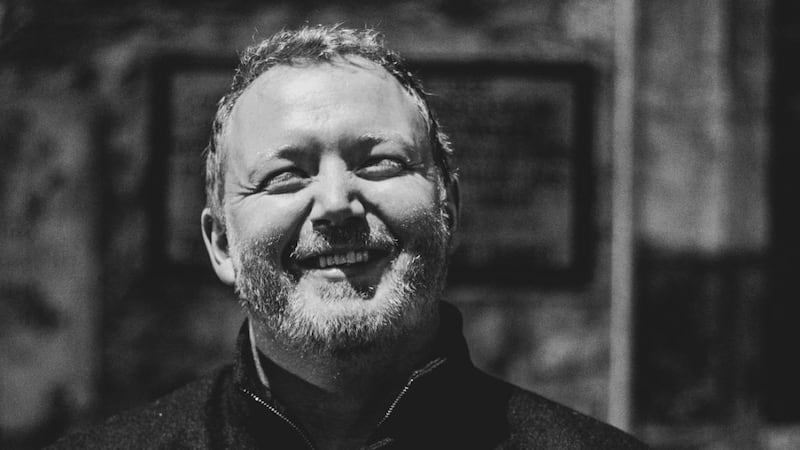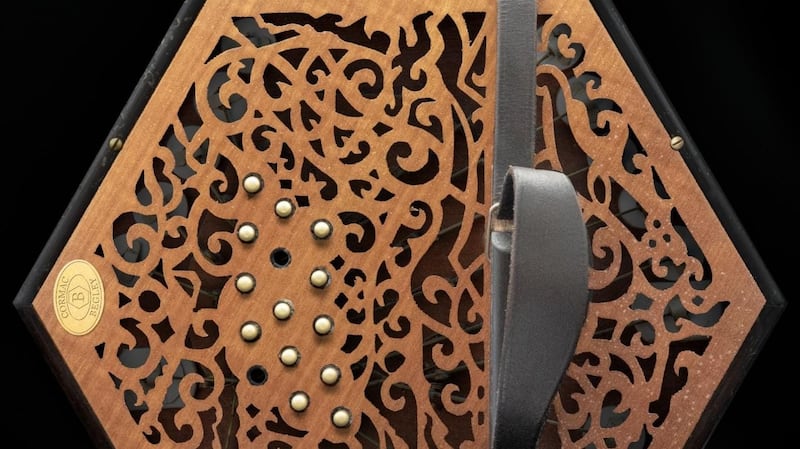Wild abandon and emotional depth charges. These are what characterise Cormac Begley’s second solo album, B. He takes a wry pleasure in describing it as the world’s first solo bass concertina album: having mined the inner workings of his chosen instrument so deeply that he’s transforming our understanding of what this traditionally mild mannered instrument can do.
B is an album that demands repeated listening, from start to finish. It's music for people whose ears, like Begley's, are drawn to the lower registers of instruments, such as the cello and bass. This is no child of the streaming age: populated with spit-polished, radio-friendly singles. It's a lovingly honed, pensive collection that emerges fully formed from the depths of west Kerry, embodied in a beautifully designed hexagonal casing (the cover reminiscent of Horslips' 1972 album cover, Happy to Meet, Sorry to Part) that mirrors the layers of the concertina itself.
Anyone with a passing interest in the workings of a musical instrument would be well advised to savour the multiple leaves of B’s cover, within which Begley shares tales of the many storied tunes he has chosen, intertwining them within the beautifully wrought design that itself reveals landscape features of his homeplace. This is an album to be savoured physically as well as aurally, revealing its riches gradually, with each return visit.
The title references many things close to Cormac Begley’s heart. B stands for bass, baile (home), Beaglaoich, Begley and blueprint, and crucially, as he says on his own liner notes “a list of insults in both the Irish and English language!”
B is an album of tunes played on the bass and baritone concertinas, and follows Begley’s 2017 solo debut in which he celebrated the full spectrum of concertina sounds from piccolo and treble to baritone and bass. It’s a product of two years spent, unexpectedly, in west Kerry. He caught the last flight out of New Zealand when the pandemic struck two years ago and, after over a decade in academia, he figured the time was right to burrow deep beneath the skin of two instruments that he had been acquainting himself with over a number of years. This is a journey to the dark side that’s as alluring as it is challenging, rambunctious and deliciously unpredictable.
Landscape and parish
“I felt that to get the most out of these instruments”, he explains, “I needed to play them in, to loosen them out, and to get to know them, and to have a better relationship with them.”
He spent lockdown in west Kerry, living close to the home in which he grew up, a stone’s throw from Brandon Creek. The Begley spirit is writ large on this recording, where wit and an unmistakable sense of time and place, as well as a capacity for survival are essential parts of the DNA.

“Being at home, it felt like the right place to do it,” Begley explains. “I saw a lot of my family and friends, people I hadn’t seen consistently in 10 years. Being around my uncles and aunties, being back in the Gaeltacht, reconnecting, improving my Irish: it felt like the right decision to record on the peninsula. And in the artwork, to include the mountain ranges from Paróiste Múrach, so everything you see on the front cover are all parts of the landscape you can see from that parish. A lot of those energies I felt from reconnecting, and the questioning of work and what I was doing with myself, with plans being put on pause: I tried to channel all that energy and frustration into this album.”
Tattooed into the album design are images of west Kerry, designed by Domhnal Ó Bhric, so that the physical album carries subtle echoes of the music that reveal themselves to listeners with an appetite for deeper exposure to the roots of the music. Surely an act of true faith in an age when streaming is king?
“I enjoyed that process of designing and making the album,” Begley admits, “because recording can be tough, tough on the mind. Dealing with all your demons and insecurities. But working with Domhnal Ó Bhric and tying the album together with my own place and where I’ve been for the past two years, I enjoyed that. Then, prototyping and the physical side of it. There’s a value in that. I wouldn’t be a huge fan of digital downloads anyway: there’s less weight in it, somehow.”
For him, the investment was more than worthwhile.
“I enjoy putting my energy and money into that because when you’re on your deathbed you want to be able to look back on your work and stand over it and know it had integrity,” he says. “The artists that I look to, it’s the integrity of their work that attracts me, and what they will leave behind. It’s not about money. It’s about the choices you make about the art that counts.”
Drone effects
The question of the relationship between the artist and the art is an enduring one, explicitly mined by Yeats, Seamus Ennis and so many others. It's in the intertwining of the two, Begley insists, that work of value emerges.
“Music and art mirrors the person,” he offers gently. “What I learned from my father was to be honest in your playing and not to shy away from that. To be your own person. That’s what I strive to do. To feel and to find tunes that suited the instruments. Your frustrations are let out during polkas or slides, or high-impact tunes, and the bass definitely helped with that. Because it’s less-trodden ground, there’s a lot more freedom too, because there’s no blueprint in it. When there’s a blueprint, you can find yourself referencing yourself to something else. So that was a freedom. My first album went way better than I could ever have expected, and this time I felt less pressure, and more freedom to explore. I was just trying my best to represent myself.

“Often when I’m playing, I imagine that I’m at a concert or a performance and I play what I’d love to hear at that point in time. And if I enjoy that, I think that’s what matters. I’d rather go for it and fail, than not to go for it.”
Cormac has worked closely with concertina makers to design an instrument with levers that allow for full drone effects. This lends a piping quality to the sound of the album. Add to that the vigorous percussion he achieves with the bellows and the exploitation of the “breath” of the concertina to add further layers to the tunes, and what you’ve got is a dramatic reimagining of traditional tunes, some very familiar, others less so, but all of them refusing to cleave to any preordained notion of what a tune should sound like.
“I think that it’s a cross between the instrument, the style of playing and the energy of the person who’s playing”, Cormac suggests. “It does take a level of strength to play at the pace I play at. There’s a balancing act: you’re either in or you’re not. To get that bigger reed sound requires a certain pressure, and if you don’t apply that pressure, you won’t get any sound, and if it’s too much pressure, there won’t be any sound either. Playing with bigger reeds, you learn how to treat them, and other sounds come out naturally as a result. But it does take a certain level of physicality and there’s something about embodying the message of the tune in your playing too.
“There are a few war-type tunes between O’Neill’s Cavalcade and a hidden track at the end, Brian Ború’s March and my own tune, To War. These are a few combative pieces and I try to visualise being in battle to get those sounds. For me part of it is medieval. I hear swords, close combat. Your senses are heightened. You can see and feel everything. And that’s how I approached this album.”
The embodiment of human experience in the concertina itself is at the heart of B.
“There are so many different types of breath,” Cormac muses. “If you’re meditating, if you’re walking, if you’re running, if you’re in close combat. If your adrenaline is up, your breathing changes. I try to reflect that because the concertina can’t sound without breathing. It’s nearly human, really.”
B is out now. Cormacbegley.com



















